Back to Top
Choose the Right Firearm
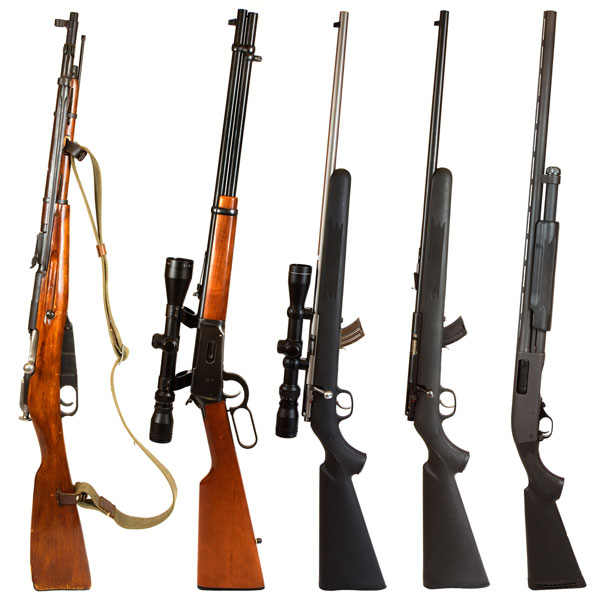
Types of Hunting Firearms
Modern hunters employ a wide variety of firearms across all parts of the country. Some specialists and enthusiasts prefer to use antiquated firearms, such as spears, but most of America’s mainstream hunters tend to opt for conventional options, such as bows and guns. Regardless of preference, today’s hunters are taking part in a tradition dating back thousands of years.
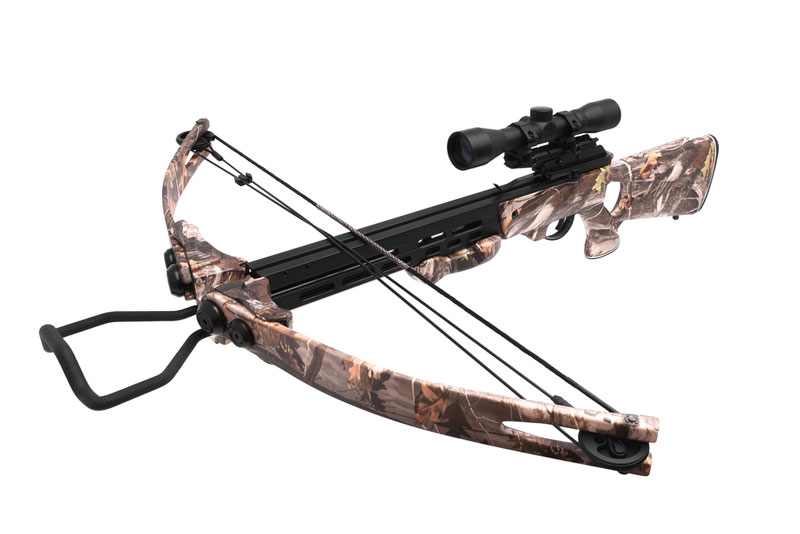
Modern archery firearms are available in two forms: bows and crossbows. Traditional bows require the hunter to “knock” (load) and “loose” (fire) an arrow at their prey. Bows come in a few different varieties, such as the traditional recurve bow or the more sophisticated compound bow. Crossbows, on the other hand, are held like rifles, fired with a trigger, and mounted on stocks that shoot projectiles called bolts.
Firearms are the most popular method used to fall game today. They are incredibly varied, with size, power, weight, and range differing per individual application. Hunting firearms are generally divided between the two broad categories of long guns and handguns (pistols). Long guns are usually fired from the shoulder and require the use of two hands, while pistols may be fired single-handed. Long guns are generally more powerful and accurate than handguns, which are primarily used as sidearms (although some people opt to hunt exclusively with pistols).
Handguns
Generally speaking, handgun hunting is less popular than long gun hunting, with most hunters using handguns as back-up firearms for safety and security purposes. It’s much easier for a surprised hunter to draw and fire a pistol than a bulky rifle if forced to ward off an aggressive predator. The three varieties of modern pistols are revolvers, autoloaders, and muzzleloaders.
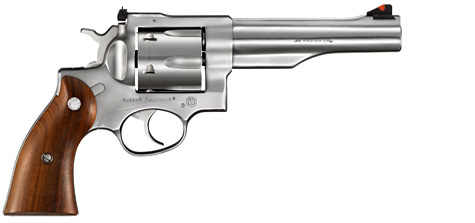
Revolvers typically hold six bullets in a rotating cylinder that aligns with the firing mechanism as the firearm is cocked or discharged, including everything from old school “six-shooters” to double-action magnums.
.jpg?sfvrsn=1b928a6f_4&MaxWidth=400&MaxHeight=260&ScaleUp=false&Quality=High&Method=ResizeFitToAreaArguments&Signature=C119CB8A5233FA98924DE7566EE32B793DB31E58)
Springfield Armory 1911
Autoloaders are semi-automatic pistols that feed ammunition from an ejectable magazine with each subsequent pull of the trigger. Many soldiers and police officers usually carry autoloading pistols while on duty.

Optima V2 Muzzleloader
Muzzleloaders were the earliest types of handguns and are a favorite among pistol-hunting enthusiasts. These firearms are loaded by ramming and packing projectiles and gunpowder down the very front of the barrel.
Long Guns
The three broad categories of long guns include shotguns, rifles, and muzzleloaders. Each are used for differing reasons, at varying times of the year, to pursue many types of game.

Winchester SX4 Shotgun
Shotguns are smoothbore firearms (so called because their barrels lack any sort of internal grooves or rifling) that fire a spray of small pellets called shot. The ability to project a wide cone of fire makes shotguns ideal for taking down flying or fast-moving targets, such as game birds or rabbits.

Mauser M98 Rifle
Rifles only fire a single projectile, instead of a cone of shot, but feature internally-grooved (rifled) barrels that cause their bullets to spin in flight. Rifling ultimately provides superior range and accuracy, making these firearms the top choice for most hunters.

Thompson Center Pro Hunter FX Muzzleloader
Muzzleloaders are the oldest type of long gun and, like their handgun counterparts, are loaded with gunpowder and projectiles from the very front of the barrel. Muzzleloaders are available in both smoothbore and rifled versions. These firearms are popular among skilled enthusiasts seeking a challenge.
More about Shotguns and Hunting Rifles
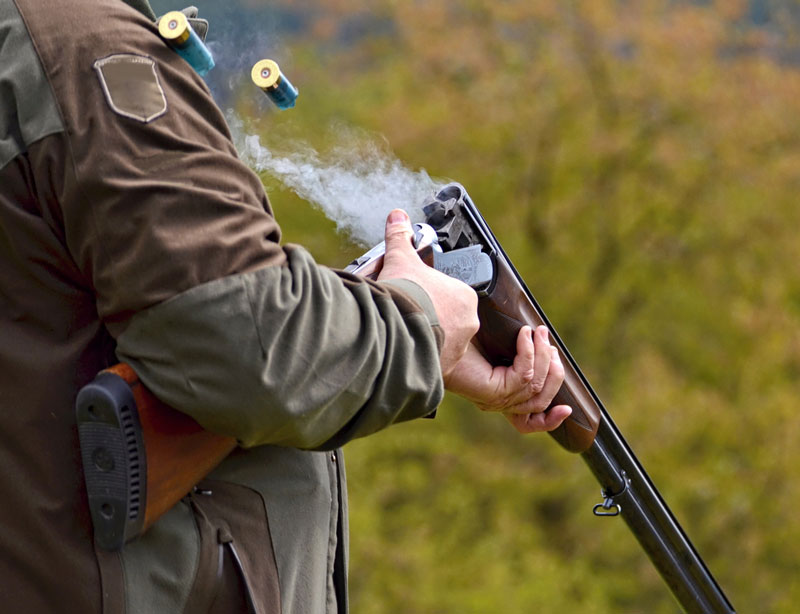
Shotguns and rifles are the most common types of firearms used by today’s hunter. Besides major differences in ammunition used, shotguns and rifles are distinguishable from one another based upon their action (method of operation), the inner diameter of their barrels (referred to as gauge, bore, or caliber), and the type of ammunition they fire (shells for shotguns and cartridges for rifles).

(Source)
The key difference between actions is the mechanical method in which the ammunition is introduced to the firing chamber of the firearm. Break-action shotguns come in single or double-barreled varieties but require the shooter to manually load shells with each shot expended. Pump-action shotguns chamber shells, from an integral magazine, with each pump or stroke of an articulated forend. Semi-automatic shotguns, on the other hand, automatically chamber subsequent shells with each shot fired.
Barring a few exceptions, today’s most common types of shotguns are pump, semi-automatic, and break-action firearms. Popular hunting rifles primarily consist of bolt and lever-action firearms, although some hunters use pump, semi-automatic, and break-action rifles as well. Except for semi-automatic and a few break-action firearms, all these firearms discharge a single mass of shot or bullet with each pull of the trigger.
Pump, and break-action rifles are exceedingly rare but principally operate the same as their shotgun counterparts. Semi-automatic rifles are a bit more common and are capable of accommodating many needs. Most rifle hunters, however, prefer single-shot, bolt-action firearms that come in variety of powerful calibers. Lever-action rifles are popular as well and chamber rounds using a lever mounted to the bottom of the firing mechanism (receiver).
Bores, Gauges, and Calibers
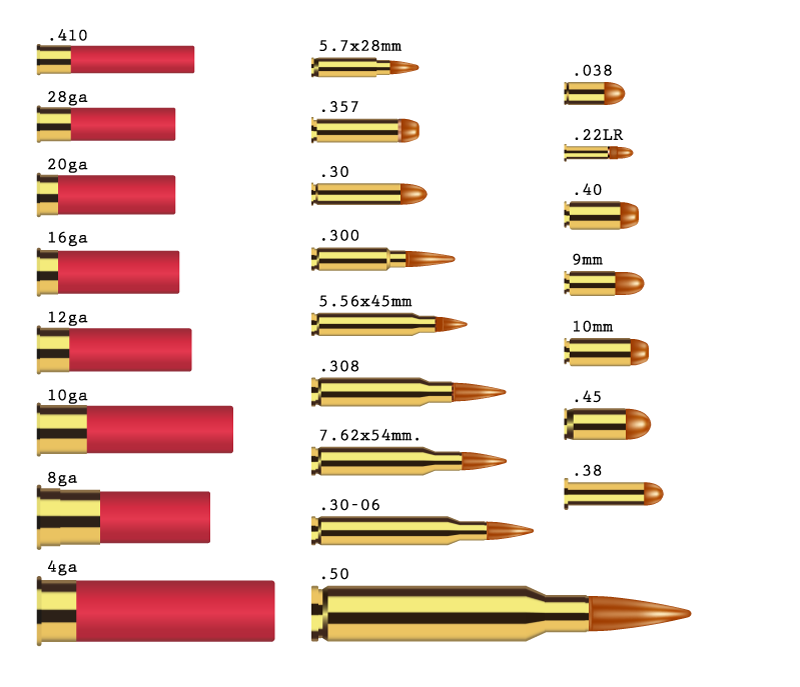
Another important feature of firearms is the relative size of their barrels. Diameter and length are both of critical importance in selecting the right firearm for your hunt. Bigger bores, or larger inner-diameters, generally translate to greater power. Length impacts range and accuracy, with longer barrels usually improving both.
The bore of a shotgun is referred to as its gauge, while the bore of a rifle is referred to as its caliber. Gauge is calculated relative to the spherical size or mass of shot that is discharged from a shotgun barrel. Today’s most popular gauges (from smallest to largest) include .410 (“four-ten-gauge”), 28ga, 20ga, 12ga, and 10ga. Gauge are inversely labeled, with physically larger bores represented by decreasingly smaller numbers (a 12ga shotgun, for example, fires a larger mass of shot than a 28ga).
Rifle calibers come in a variety of sizes but are labeled a bit more conventionally. Calibers are expressed in either standard and metric measurements, with both referring to the inner-diameter of barrels. A typical thirty-caliber rifle, for example, is built around a barrel with an inner-diameters of .30 inch, while a 7mm rifle has an inner-barrel diameter of seven millimeters. Larger calibers are typically used for larger game. A .22 rifle, for instance, would be great for taking care of vermin or pests but completely underpowered and inappropriate if, for example, hunting elk or moose.
Rifles and Ammunition

The identification and choosing of ammunition is unquestionably linked to firearm selection, with modern rifle ammunition being the most popular of choices. Ammunition is not interchangeable, meaning that the caliber of the cartridges loaded into a firearm must match its bore size. Bigger is not always better, with some smaller caliber bullets sometimes delivering a greater wallop than larger ammunition. Sound confusing? Read on.
The best place to start when discussing ammunition is the basic parts of a rifle cartridge. The four major components of a cartridge are the case, powder, primer, and projectile.
Most of today’s cases are made of brass and contain a measure of combustible powder or propellent. Black powder is loud, messy, and used in muzzleloaders. Smokeless powder, on the other hand, is used in most modern rifles and shotguns.
A primer is an ignition device located on the back of the case (centerfire and rimfire cartridges derive their names from the specific locations of their primers—located in the dead center or around the rear rim of the cartridges, respectfully).
At the opposite end of the cartridge is the projectile (or bullet). The action of pulling the trigger drops a hammer, which pushes a firing pin into the primer that ignites the propellent, which explodes and projects the bullet down the length of the barrel.

(Source)
Bullets are typically made of lead—a soft but dense metal that “mushrooms” upon impact, transferring a great deal of kinetic energy to the intended target. They come in a variety of shapes and sizes, which are designated by various acronyms and units of measure (FMJ stands for “Full Metal Jacket” for example). The jacketing, or covering, of bullets in a thin layer of durable metal increases ballistic performance and penetration. The mass of projectiles is expressed in grains, with 437.5 grains equaling one ounce.
Cartridges are measured by their diameter, or caliber, but other conventions are important as well. Length and manufacturer are sometimes used to denote key differences. The .303 British, for example, is roughly the same diameter as the 7.62×39mm Soviet but used in two very different firearms. Another common labeling practice is to include the year in which certain ammunition was invented or adopted for popular use. The .30-06 (“thirty-ought-six”) Springfield, for example, is a popular thirty-caliber hunting cartridge first introduced as service ammunition by the U.S. Army in 1906.

(Source)
Stopping power and range are dictated by many performance variables, including projectile mass, muzzle velocity, and bullet trajectory. Even the most experienced hunters ceaselessly debate the merits of specific cartridges for certain applications. Most, however, find a favorite and tend to stick with it. Suggestions concerning the selection of popular rifle calibers are located near the end of this article.
Shotgun Ammunition
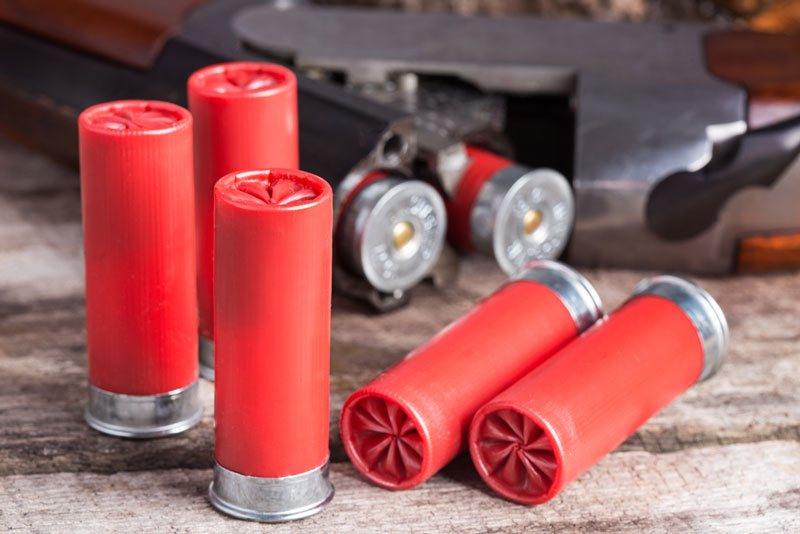
A standard shotgun cartridge houses pellets and packing material inside of self-contained plastic shell (sometimes called a hull) that’s attached to a brass casing with an integral primer. In addition to diameter, or gauge, shells are also measured in length, which corresponds to the length of the chamber of the shotgun from which they are fired (usually anywhere from 2 3/4” – 3 1/2”). Some specialized types of shotgun ammunition house solid projectiles, rather than pellets, for taking down larger game. Individual pellets are referred to as shot, while large projectiles are called slugs. Both come in a variety of types and sizes to satisfy different requirements.
Shot is primarily available in both lead and steel varieties, with the former facing dwindling use due to environmental concerns and waterfowl hunting regulations. A recent rise in many upland bird hunting regulations has further limited the use of lead shot. While it’s decidedly of lesser impact on the environment, steel is lighter than lead and thus retains less energy, resulting in decreased performance. Regardless, hunters must conform to local laws so be sure to consult yours prior to making a purchase.
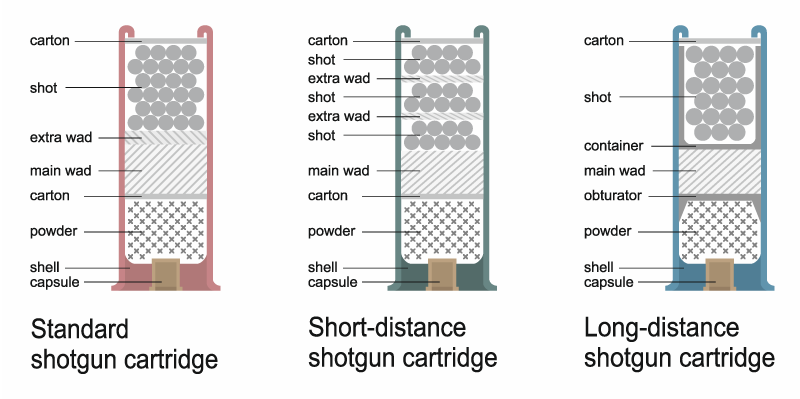
Shot is measured by the spherical diameter of individual pellets, the weight of total pellets in an individual shell, and is separated into two general categories. Birdshot is small and intended for small game and birds. Buckshot, meanwhile, is meant for larger game, such as deer and elk. Like gauge measurements, shot numbers are inversely proportional to size.
Number 4 lead buckshot, for example, consist of .24" diameter pellets. Double-ought-buck (#00 shot), on the other hand consist of .33” diameter pellets. Since shells come in varying lengths and gauges, the number of individual pellets loaded into different hulls varies. A 1 oz. shotshell load of #9 shot, for example contains 585 pellets, while 1 oz. of larger #2 shot consists of only 87 pellets. Larger shells can accommodate greater loads, so a 2 1/4 oz. load will contain more pellets than a 1 1/2 oz. load of identical-sized shot.

Slugs fill a needed niche, when certain safety regulations or seasonal restrictions otherwise prohibit the use of long-range rifles. A bit less complicated than shot, they are offered in three different varieties:
Standard slugs are essentially large hunks of lead designed to be discharged from smoothbore shotguns. They are intended for taking medium-sized game at relatively short distances.
Rifled slugs are designed for use in standard, smoothbore shotguns but sport their own rifled grooves, essentially making them spin like bullets fired from a rifle. This helps in improving range and accuracy.
Saboted slugs consist of a specialized projectile, called a sabot (pronounced “say-bo”) that’s designed to be fired out of rifled shotguns. A recent development, saboted slugs (and the special shotguns that fire them) are comparatively expensive and therefore somewhat cost prohibitive. The additional expense translates to superior range and accuracy. Slug diameter generally corresponds to gauge size (a standard 12ga slug, for example, is about 3/4” in diameter).
Putting it All Together
Still not sure about what type of firearm is right for you? Not to worry. Experienced hunters expend a great deal of time and effort preparing for their hunts and countless pages of numerous outdoors periodicals are filled with opinions regarding the appropriate selection of firearms and equipment. All that said, the below guidelines, along with your new knowledge of firearms, should get you pointed in the right direction.
1. Rifles are great for taking down nearly any type of land animal but limited on when and where they can be used throughout the year. Smaller calibers are appropriate for small game, while larger calibers are generally more appropriate for larger game. Bolt-action rifles, with powerful scopes, are generally preferred for long-range shooting, whereas lever-action rifles are better suited for medium-range brush hunting. Presented below are three of the best hunting rifles offered today. The first two made Game and Fish Magazine’s list of most popular hunting rifles of 2017, while the third is a budget-friendly favorite.

Remington Model 700 American Wilderness: A durable bolt-action rifle and seminal favorite available in .270 Win. (Winchester), .30-06, 7mm Rem. (Remington) Mag. (Magnum) or .300 Win. Mag.

Savage 11/111 DOA Hunter XP: A newer-model rifle ready to “shoot straight out of the box.” Includes a lot of great features, like a factory mounted scope, box magazine, and adjustable trigger pull. Available in a variety of calibers, from .243 to .338 Win. Mag.

Ruger American Rifle Standard: A easy-on-the-pocketbook-rifle ideal for novice hunters or those new to shooting in general. Despite its low price tag, the Ruger still comes packed with a assortment of awesome extras, like an adjustable trigger pull, complementary magazine, and soft rubber (recoil reducing) buttpad. Ruger produces the American in a variety of calibers, ranging from .22-250 Rem. to .308 Win.
2. If hunting medium to large-size game, shotguns are generally preferred only as a matter of observing safety regulations or obeying local laws. Seasonal restrictions, for instance, sometimes limit when rifles can be used, leaving shorter range shotguns a viable alternative. Shotguns are ideal, however, for bird hunting and, in some cases, small game hunting. According to a recent Field & Stream article, some of 2017’s best shotguns included:

Mossberg International SA-28: This 28-gauge autoloader is a perfect example of why Mossberg has such an outstanding reputation for making great entry-level shotguns. From its light weight to low recoil, the SA-28 is an excellent choice for novice shotgunners interested in target or wing-shooting alike.

Benelli Super Black Eagle 3: At three to four times the cost of the Mossberg SA-28, this 12-gauge Benelli is intended for serious waterfowl hunters only. Another autoloader, the Benelli received accolades in nearly every category and features a patented feeding mechanism that makes loading shells a snap.

Caesar Guerini Tempio Light: The most expensive of the three shotguns presented here, the Tempio Light is a high-end, over-under, break-action shotgun built with the true collector in mind. It’s considered a fine-looking specialty firearm, ideal for upland bird hunting, and a prime example of how cosmetics are an important element of some shotgun designs.
3. A great deal of myths and untruths surround muzzleloader hunting but a few things do hold true. On the one hand, muzzleloaders can be a little more difficult to store and operate than modern hunting rifles. They rely upon black powder, a propellent particularly susceptible to condensation and moisture, which is unreliable when damp. On the other hand, they are generally accurate and powerful enough to takedown common game. Outdoor Life published a 2014 article that discusses the ups and downs of muzzleloaders in detail.
Final Thoughts
Regardless of the many options and opinions surrounding the proper selection of a hunting firearm, the ultimate choice largely comes down to preference. Some hunters prefer taking long-range shots at large game, while others are thrilled at the challenge of hunting fast-moving waterfowl. Many hunters enjoy tracking their prey across miles of wilderness, whereas an equal number prefer the stationary practice of baiting game and occupying a pre-staged blind. For more suggestions on selecting a great firearm, be sure to check out our blog about the top hunting rifles of 2018.
There’s a right and wrong firearm for each job; it’s up to the individual hunter to choose the best fit, while also observing the letter of the law. That said, even the best firearm is ineffective in untrained hands. It’s therefore important to spend some time handling and shooting the firearm in a safe and approved location. To learn more, it’s best to start with target shooting or possibly considering the services of a hunting guide.